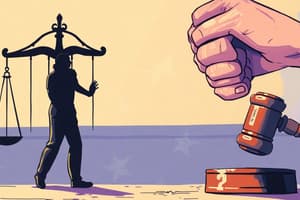Podcast
Questions and Answers
What is the purpose of bail in the criminal justice system?
What is the purpose of bail in the criminal justice system?
- To allow suspects to leave jail without any conditions.
- To provide income for the court system.
- To guarantee the defendant shows up for court. (correct)
- To ensure the defendant is punished before trial.
Which statement about pretrial detention is TRUE?
Which statement about pretrial detention is TRUE?
- A judge may deny bail if the defendant is deemed a flight risk. (correct)
- Pretrial detention is allowed only if the defendant has been convicted.
- Pretrial detention is mandatory for all criminal cases.
- All defendants are entitled to bail.
What must the prosecution prove in a criminal trial?
What must the prosecution prove in a criminal trial?
- The probability of the crime occurring.
- The defendant's guilt beyond a reasonable doubt. (correct)
- The defendant's innocence beyond a reasonable doubt.
- The defendant's motivation for the crime.
What is referred to as plea bargaining?
What is referred to as plea bargaining?
What is the highest evidentiary standard in a criminal trial?
What is the highest evidentiary standard in a criminal trial?
Who is responsible for determining the facts of a case during a trial?
Who is responsible for determining the facts of a case during a trial?
What happens to a defendant's bail if they fail to appear in court as required?
What happens to a defendant's bail if they fail to appear in court as required?
What could be a possible outcome of a sentencing phase after a guilty plea or verdict?
What could be a possible outcome of a sentencing phase after a guilty plea or verdict?
What does the American legal system being adversarial mean?
What does the American legal system being adversarial mean?
Is the right to bail a constitutional guarantee?
Is the right to bail a constitutional guarantee?
What role does the probation office play in the federal sentencing process?
What role does the probation office play in the federal sentencing process?
Which of the following statements about appeals is true?
Which of the following statements about appeals is true?
What is typically the outcome of a successful appeal?
What is typically the outcome of a successful appeal?
In the appeals process, what document does the appellant use to present their arguments?
In the appeals process, what document does the appellant use to present their arguments?
When may a federal court depart from the sentencing guidelines?
When may a federal court depart from the sentencing guidelines?
Which of the following is NOT a typical function of the corrections system?
Which of the following is NOT a typical function of the corrections system?
What happens to a litigant who loses in a federal court of appeals?
What happens to a litigant who loses in a federal court of appeals?
What is the typical composition of a panel in the United States Circuit Courts during an appeal?
What is the typical composition of a panel in the United States Circuit Courts during an appeal?
Which of the following statements about parole is correct?
Which of the following statements about parole is correct?
In which scenario may an appeal not require a rehearing by the trial court?
In which scenario may an appeal not require a rehearing by the trial court?
What does it mean for an offender to have served a complete prison sentence and 'flat timed'?
What does it mean for an offender to have served a complete prison sentence and 'flat timed'?
How does the criminal justice system resemble a funnel?
How does the criminal justice system resemble a funnel?
What might prevent a case from resulting in a conviction?
What might prevent a case from resulting in a conviction?
What happens to the number of cases as they progress through the criminal justice process?
What happens to the number of cases as they progress through the criminal justice process?
Which of the following is NOT an example of how a case can exit the criminal justice system?
Which of the following is NOT an example of how a case can exit the criminal justice system?
Why might police decide to deal with a case informally?
Why might police decide to deal with a case informally?
What is a consequence of the funnel effect in the criminal justice system?
What is a consequence of the funnel effect in the criminal justice system?
What may influence a judge's decision to opt for treatment over imprisonment?
What may influence a judge's decision to opt for treatment over imprisonment?
Which of the following statements is accurate regarding offenders who are finished with their prison time?
Which of the following statements is accurate regarding offenders who are finished with their prison time?
What is a potential reason for a prosecutor to decide not to prosecute a case?
What is a potential reason for a prosecutor to decide not to prosecute a case?
Study Notes
Pretrial Detention & Bail
- Pretrial detention involves keeping a suspect in jail until trial.
- Most criminal suspects are released on bail before trial.
- Bail is a sum of money paid by the defendant to ensure their appearance in court.
- Failure to appear results in bail forfeiture and a warrant for their arrest.
- The right to bail is not guaranteed by the Constitution, but excessive bail is prohibited.
- If a judge deems a defendant a flight risk, they may deny bail, resulting in pretrial detention.
Plea Bargaining
- Plea bargaining is an agreement where the defendant pleads guilty to a lesser crime or receives a reduced sentence.
- It is a common practice in the criminal justice system, though it faces criticism.
Trial
- Trials aim to determine the defendant's guilt.
- Guilt must be established based on evidence.
- The "finders of fact" are either a jury or a judge (bench trial).
- The legal system is adversarial, with prosecution proving guilt and defense demonstrating innocence.
- The burden of proof lies with the prosecution.
- Guilt must be proven beyond a reasonable doubt, the highest standard of evidence.
Sentencing
- Sentencing follows a guilty plea or verdict, and can include:
- Monetary fines
- Probation
- Jail or prison time
- Combinations of supervision and incarceration
- Federal sentencing guidelines help determine the defendant's sentence.
- The court's probation office prepares a report applying the guidelines to the individual case.
- During sentencing, the court considers evidence from trial, pretrial services officers, prosecutors, and defense attorneys.
- Departures from the sentencing guidelines are possible in exceptional circumstances.
- Federal sentencing guidelines have been controversial, leading to numerous appeals.
- Federal sentences can include prison time, fines, and restitution to victims.
- Probation officers aid in enforcing sentencing conditions.
- Supervision can involve substance abuse testing, treatment programs, job counseling, and alternative detention options.
Appeal
- Trial court decisions can be appealed to higher courts.
- Appeals aim to correct legal errors.
- A successful appeal usually leads to a rehearing of the case by the trial court.
- The prosecutor can choose not to pursue the case if the legal error makes proving guilt beyond a reasonable doubt impossible.
- Defendants, but not the government, can appeal guilty verdicts.
- Both sides can appeal sentences after a guilty verdict.
- The party filing an appeal is called the appellant.
- Appellants must demonstrate a legal error affecting the trial court's decision.
- The court of appeals relies on the trial court's record, not new evidence.
- Appeals in the United States Circuit Courts involve panels of three judges.
- Appellants submit legal arguments in briefs, attempting to persuade the judges to overturn the trial court's decision.
- The appellee, defending against the appeal, argues for the trial court's decision or downplays the impact of any errors.
- While some cases are decided based on written briefs alone, many involve oral arguments.
- Oral arguments are structured discussions between lawyers and judges focusing on legal principles.
- The court of appeals' decision is generally final, unless the case is sent back for further proceedings or the parties appeal to the Supreme Court.
- En banc review, by a larger group of judges, may occur in certain cases.
- A party losing in a federal court of appeals or state supreme court may file a petition for a writ of certiorari to the U.S. Supreme Court, which the Court may grant or deny.
- The Supreme Court typically grants review only in cases with significant legal principles or conflicting interpretations by lower courts.
- The Supreme Court may require review in certain special circumstances.
- When the Supreme Court hears a case, the parties file briefs and may participate in oral arguments.
Corrections
- The goal of corrections is to protect the public and serve the public interest through punishment or rehabilitation.
- Corrections encompass broader aspects than just prisons and jails, including early release mechanisms like probation and parole.
- The U.S. corrections system is vast, managing about 7 million individuals under supervision.
- While only about a third of convicted offenders are incarcerated, the number of prisoners is substantial.
- The cost of corrections is significant, leading to political debate.
Release from the System
- The final stage of the criminal justice process is release.
- Parole release requires meeting specific conditions and restricts the offender’s freedom.
- Those completing their prison sentences without parole supervision have full freedom.
The Criminal Justice funnel
- The criminal justice system is often compared to a funnel, narrowing as it progresses.
- Fewer cases reach conviction and incarceration at each stage.
- Cases drop out at various steps due to informal resolution, prosecutorial decisions, judicial choices, etc.
- Only a small percentage of known crimes lead to prison sentences.
Studying That Suits You
Use AI to generate personalized quizzes and flashcards to suit your learning preferences.
Description
This quiz covers essential concepts in the criminal justice system, including pretrial detention, bail procedures, plea bargaining, and trials. Understand the intricacies of legal processes and the rights of defendants during proceedings. Test your knowledge on how justice is served and reinforced in the courtroom.




